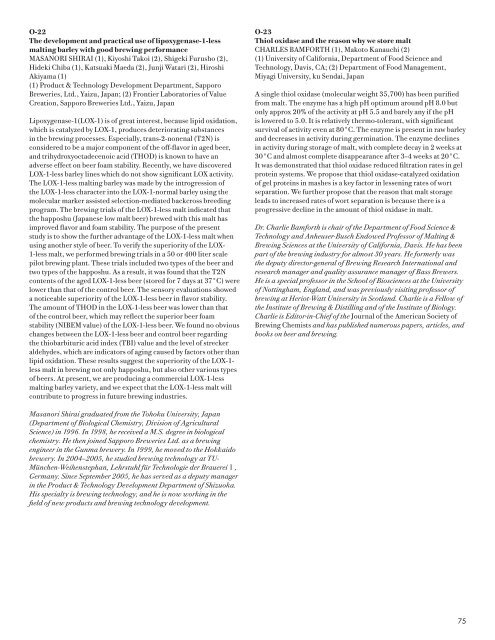Program Book - Master Brewers Association of the Americas
Program Book - Master Brewers Association of the Americas
Program Book - Master Brewers Association of the Americas
You also want an ePaper? Increase the reach of your titles
YUMPU automatically turns print PDFs into web optimized ePapers that Google loves.
O-22<br />
The development and practical use <strong>of</strong> lipoxygenase-1-less<br />
malting barley with good brewing performance<br />
MASANORI SHIRAI (1), Kiyoshi Takoi (2), Shigeki Furusho (2),<br />
Hideki Chiba (1), Katsuaki Maeda (2), Junji Watari (2), Hiroshi<br />
Akiyama (1)<br />
(1) Product & Technology Development Department, Sapporo<br />
Breweries, Ltd., Yaizu, Japan; (2) Frontier Laboratories <strong>of</strong> Value<br />
Creation, Sapporo Breweries Ltd., Yaizu, Japan<br />
Lipoxygenase-1(LOX-1) is <strong>of</strong> great interest, because lipid oxidation,<br />
which is catalyzed by LOX-1, produces deteriorating substances<br />
in <strong>the</strong> brewing processes. Especially, trans-2-nonenal (T2N) is<br />
considered to be a major component <strong>of</strong> <strong>the</strong> <strong>of</strong>f-flavor in aged beer,<br />
and trihydroxyoctadecenoic acid (THOD) is known to have an<br />
adverse effect on beer foam stability. Recently, we have discovered<br />
LOX-1-less barley lines which do not show significant LOX activity.<br />
The LOX-1-less malting barley was made by <strong>the</strong> introgression <strong>of</strong><br />
<strong>the</strong> LOX-1-less character into <strong>the</strong> LOX-1-normal barley using <strong>the</strong><br />
molecular marker assisted selection-mediated backcross breeding<br />
program. The brewing trials <strong>of</strong> <strong>the</strong> LOX-1-less malt indicated that<br />
<strong>the</strong> happoshu (Japanese low malt beer) brewed with this malt has<br />
improved flavor and foam stability. The purpose <strong>of</strong> <strong>the</strong> present<br />
study is to show <strong>the</strong> fur<strong>the</strong>r advantage <strong>of</strong> <strong>the</strong> LOX-1-less malt when<br />
using ano<strong>the</strong>r style <strong>of</strong> beer. To verify <strong>the</strong> superiority <strong>of</strong> <strong>the</strong> LOX-<br />
1-less malt, we performed brewing trials in a 50 or 400 liter scale<br />
pilot brewing plant. These trials included two types <strong>of</strong> <strong>the</strong> beer and<br />
two types <strong>of</strong> <strong>the</strong> happoshu. As a result, it was found that <strong>the</strong> T2N<br />
contents <strong>of</strong> <strong>the</strong> aged LOX-1-less beer (stored for 7 days at 37°C) were<br />
lower than that <strong>of</strong> <strong>the</strong> control beer. The sensory evaluations showed<br />
a noticeable superiority <strong>of</strong> <strong>the</strong> LOX-1-less beer in flavor stability.<br />
The amount <strong>of</strong> THOD in <strong>the</strong> LOX-1-less beer was lower than that<br />
<strong>of</strong> <strong>the</strong> control beer, which may reflect <strong>the</strong> superior beer foam<br />
stability (NIBEM value) <strong>of</strong> <strong>the</strong> LOX-1-less beer. We found no obvious<br />
changes between <strong>the</strong> LOX-1-less beer and control beer regarding<br />
<strong>the</strong> thiobarbituric acid index (TBI) value and <strong>the</strong> level <strong>of</strong> strecker<br />
aldehydes, which are indicators <strong>of</strong> aging caused by factors o<strong>the</strong>r than<br />
lipid oxidation. These results suggest <strong>the</strong> superiority <strong>of</strong> <strong>the</strong> LOX-1less<br />
malt in brewing not only happoshu, but also o<strong>the</strong>r various types<br />
<strong>of</strong> beers. At present, we are producing a commercial LOX-1-less<br />
malting barley variety, and we expect that <strong>the</strong> LOX-1-less malt will<br />
contribute to progress in future brewing industries.<br />
Masanori Shirai graduated from <strong>the</strong> Tohoku University, Japan<br />
(Department <strong>of</strong> Biological Chemistry, Division <strong>of</strong> Agricultural<br />
Science) in 1996. In 1998, he received a M.S. degree in biological<br />
chemistry. He <strong>the</strong>n joined Sapporo Breweries Ltd. as a brewing<br />
engineer in <strong>the</strong> Gunma brewery. In 1999, he moved to <strong>the</strong> Hokkaido<br />
brewery. In 2004–2005, he studied brewing technology at TU-<br />
München-Weihenstephan, Lehrstuhl für Technologie der BrauereiⅠ,<br />
Germany. Since September 2005, he has served as a deputy manager<br />
in <strong>the</strong> Product & Technology Development Department <strong>of</strong> Shizuoka.<br />
His specialty is brewing technology, and he is now working in <strong>the</strong><br />
field <strong>of</strong> new products and brewing technology development.<br />
O-23<br />
Thiol oxidase and <strong>the</strong> reason why we store malt<br />
CHARLES BAMFORTH (1), Makoto Kanauchi (2)<br />
(1) University <strong>of</strong> California, Department <strong>of</strong> Food Science and<br />
Technology, Davis, CA; (2) Department <strong>of</strong> Food Management,<br />
Miyagi University, ku Sendai, Japan<br />
A single thiol oxidase (molecular weight 35,700) has been purified<br />
from malt. The enzyme has a high pH optimum around pH 8.0 but<br />
only approx 20% <strong>of</strong> <strong>the</strong> activity at pH 5.5 and barely any if <strong>the</strong> pH<br />
is lowered to 5.0. It is relatively <strong>the</strong>rmo-tolerant, with significant<br />
survival <strong>of</strong> activity even at 80°C. The enzyme is present in raw barley<br />
and decreases in activity during germination. The enzyme declines<br />
in activity during storage <strong>of</strong> malt, with complete decay in 2 weeks at<br />
30°C and almost complete disappearance after 3–4 weeks at 20°C.<br />
It was demonstrated that thiol oxidase reduced filtration rates in gel<br />
protein systems. We propose that thiol oxidase-catalyzed oxidation<br />
<strong>of</strong> gel proteins in mashes is a key factor in lessening rates <strong>of</strong> wort<br />
separation. We fur<strong>the</strong>r propose that <strong>the</strong> reason that malt storage<br />
leads to increased rates <strong>of</strong> wort separation is because <strong>the</strong>re is a<br />
progressive decline in <strong>the</strong> amount <strong>of</strong> thiol oxidase in malt.<br />
Dr. Charlie Bamforth is chair <strong>of</strong> <strong>the</strong> Department <strong>of</strong> Food Science &<br />
Technology and Anheuser-Busch Endowed Pr<strong>of</strong>essor <strong>of</strong> Malting &<br />
Brewing Sciences at <strong>the</strong> University <strong>of</strong> California, Davis. He has been<br />
part <strong>of</strong> <strong>the</strong> brewing industry for almost 30 years. He formerly was<br />
<strong>the</strong> deputy director-general <strong>of</strong> Brewing Research International and<br />
research manager and quality assurance manager <strong>of</strong> Bass <strong>Brewers</strong>.<br />
He is a special pr<strong>of</strong>essor in <strong>the</strong> School <strong>of</strong> Biosciences at <strong>the</strong> University<br />
<strong>of</strong> Nottingham, England, and was previously visiting pr<strong>of</strong>essor <strong>of</strong><br />
brewing at Heriot-Watt University in Scotland. Charlie is a Fellow <strong>of</strong><br />
<strong>the</strong> Institute <strong>of</strong> Brewing & Distilling and <strong>of</strong> <strong>the</strong> Institute <strong>of</strong> Biology.<br />
Charlie is Editor-in-Chief <strong>of</strong> <strong>the</strong> Journal <strong>of</strong> <strong>the</strong> American Society <strong>of</strong><br />
Brewing Chemists and has published numerous papers, articles, and<br />
books on beer and brewing.<br />
75



